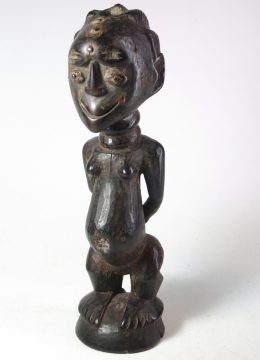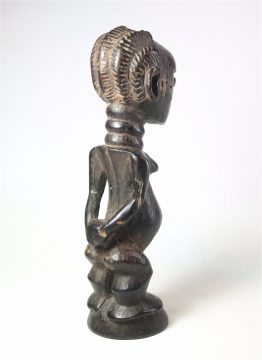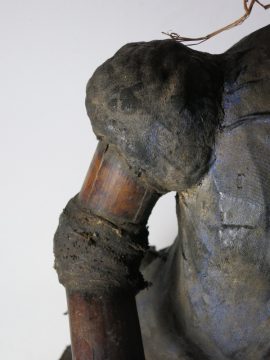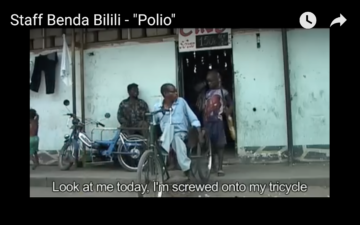Publié le 14 février 2017
Version originale : 10 février 2017
Quel genre de figure?
 Fétiche (Nkishi) : ouvertures dans le dos et le nombril
Fétiche (Nkishi) : ouvertures dans le dos et le nombril
Esclave : ses mains liées ensemble – Felix (100 Peuples) mentionne le statut traditionnel des esclaves.
Belle femme : coiffure noble élaborée avec le front rasé, le cou droit et assez long avec trois rouleaux; La femme porte 11 minuscules clous de cuivre comme ornement: 3 du nez à l’arrière, 2 aux yeux, 6 à la droite et à la gauche des tempes; elle a des yeux haricots expressifs (élévations plus ongles) et un sourire désarmant comme un visage souriant. Elle regarde directement le spectateur avec les sourcils levés et marqués et les yeux perçants, son sourire transmet la sérénité. Elle est très enceinte avec un ventre attrayant, creux inférieur dos et belles fesses. L’attitude est impeccable. Le maître n’a rien fait de superflu.
Style, design, soin et condition – Une miniature parfaite de 21 cm
Proportions: classique et vitale: Vue frontale: tête et cou plus d’un tiers (8,5 cm), le tronc des clavicules au clitoris (8,5 cm), genou, pieds et piédestal (4 cm). Et par derrière: les mains liées forment un centre abaissé : 8 cm en dessous et au dessus de 13 cm.
Design: Contours clairs et encisions fortes: cheveux, oreilles, sourcils, yeux, ailes de nez, bouche, clitoris, pieds
Polissage : Le visage apparaît plus poli que le corps, où les coupes fines sont encore visibles d’une manière agréable. Les coupes sont beaucoup plus petites que celles du cavalier Mbala.
Soin et entretien: Soin-patine sombre comme celle de mes plus anciens Ibedjis. Le front, le nez et la bouche, les seins hauts, les avant-bras, les mains attachées et les pieds montrent une abrasion brillante et reflètent la lumière, de sorte que la figurine semble toujours intéressante. Les petits défauts du bras et du bas du corps apparaissent comme des défauts du bois. Odeur fraîche très discrète.
Provenance
Qui aime douter si le fournisseur propose une provenance! Dans ce cas, c’était Zela en premier lieu, ou Luba-Katanga, Hemba, Luba-Shankadi , qui signifiait une origine à l’est de la Lualaba vers les lacs.
D’où est-ce que je connais la coiffure? De deux miniatures de médecine, de l’est du Congo à la Tanzanie. La forme en croissant de la bouche me rappelle les masques de singes des Hemba. Je cherche des arguments plus formels et les trouve dans Nooter / Roberts Memory (Luba) p.213 cat.90 : chef masculin de Kusu (bouche); p.181 cat. 75 Luba masque considérablement allongé (la bouche); p.158 fig. 149 Luba chef photo 1916 (sourcils), ainsi que dans Nooter Secrecy chat. 36 L’arc luba se dressait : cou, seins, lèvres, pieds vifs – mais l’impression générale ne souligne que les différences typiques entre les figures luba et lubaized d’un côté, et les fétiches Songye de l’autre.
Dès le premier moment j’étais convaincu d’une origine Songye-Belande-Milembwe !
Neyt: Songye p.380-81 Style I caractérisé par le sourire Makishi, dans une région à 100 km à l’ouest de la Lualaba et aujourd’hui à environ 200 km au nord-ouest de la proposition, Zela.
Les meilleurs exemples sont cat. 4 et 8 , les deux 58 cm de haut:

Neyt-Songye, Tf. 4 style I

Neyt-Songye, Tf. 8 style I
Arguments pour une origine des Songye-Belande dans la région de transition vers Luba!
- Pas de fille Luba timide avec des yeux baissés et des mains-à-ses-seins, mais sûre d’elle.
- Pas de tatouage du ventre, mais un petit tatouage cloué au visage qui pourrait tout aussi bien avoir la fonction de médicaments.
- L’ouverture dans le crâne aurait pu loger une corne ou un bouchon sur certains médicaments
- Le corps hautement enceinte avec le dos creux typique, l’agilité physique, le sourire effronté et l’ouverture
- en particulier les pieds et le piédestal: la bande de séparation droite entre les pieds et leur adaptation active à la base hémisphérique
- Je ne vois nulle part dans le livre cette solution technique pour les yeux, mais le même effet peut être atteint différemment, par exemple par des globes oculaires également bossu.
-

Neyt_Miniatures Zaire Songye Titel

Neyt_Miniatures Zaire Songye 21 cm
Resolution par Palaver (or Brainstorming )
Maintenant W. entre la scène. Il est congolais aussi, et il confirme son collègue: la coiffure est purement Luba, et aussi le nez, les fesses, les jambes. Il nous montre même sur son smartphone ce genre de bouche – comme une demi-lune – comme Luba. Les pieds sont cependant absolument Songye. Après tout, il situe la figure sur la même frontière intertribale que moi. (Je suis un bon client!) Son compatriote se corrige légèrement: Autour de Kongolo sur le Luba Luba live, Hemba et Songye dans un mix coloré.


Question: Les Songye avaient-ils traditionnellement des „esclaves“?
Oui, ils l’avaient. Alan P. Merriam (Un Monde Africain – Le Village Basongye de Lupupa Ngye , 1974) écrit à la p.234 à propos d‘ un deuxième type de mariage , mukashanda a bubika, qui signifie à peu près «femme esclave» (et cela à côté d’un troisième et quatrième type de mariage). La femme est acquise dans une transaction en espèces et a un statut intermédiaire fixe. Elle n’est pas une femme mulangantu . Si sa famille est connue, vous n’auriez pas à respecter son père ou sa mère. Le prix de la mariée est payé à la fois et en espèces. Sa force de travail et ses enfants appartiennent à l’homme et à sa lignée. Si la relation reste sans enfant, elle peut être revendue. Le problème de ce statut pour la femme est: Elle n’a aucun soutien dans sa famille d’origine. – Cette forme de mariage existait aussi sous le Bakongo, au moins depuis le 19ème siècle ( MacGaffey). Était-elle répandue dans tout le Congo?
Selon les informateurs de Lupupa, ces femmes ne sont jamais des Songye, mais plutôt des Luba ou des Tetela. – Nous avons donc affaire à des étrangers. Cela ne correspond-il pas parfaitement à l’institution du fétiche? J’ai lu un peu dans Fritz Kramer „Der rote Fez“ sur le „pepo“ sur la côte Est (page 99 et suivantes) et j’ai quelques idées:
Oui, la femme achetée de l’extérieur peut souffrir d’un manque de soutien; et ses enfants sont expropriés, mais elle reste aussi étrangère à son mari. Questions intéressantes: Pourquoi l’a-t-il épousé? Quel était son rôle social dans le village?
Le fétiche incarne aussi une sorte d’étrangeté similaire. Est-ce que les mains liées indiquent plus le statut d’étrangeté que le manque de liberté? Le symbole des mains liées sous cet aspect peut-il être comparé à la bisexualité ou à la duplicité des autres figures de Makishi?
Chez les Milembwe et les Belande, on fabrique souvent des Makishi purement féminins. Est-ce que les mains liées indiqueraient la présence d’un esprit capturé dans le Nkishi si les mains n’étaient pas nécessaires pour accentuer l’énergie du nombril? Parfois, un masque représente déjà un esprit féminin spécial! Nous devrions vérifier à nouveau avec Dunja Hersak le statut de la sorcière parmi les Songye!
Commentaire sur l’esclavage – un tabou pour les gens autour de moi!
En Europe, toute forme d’esclavage est actuellement taboue , même si elle se produit considérablement dans notre sphère d’influence.
Merriam a parlé du cas du village de Songye. L’État providence doit intervenir par des mesures et des paiements de transfert. L’ise de la «famille nucléaire» dans la société moderne généralise l’isolement des individus. Dans des situations problématiques. Pendant ce temps, l’institution du mariage est affaiblie et dissoute dans l’arbitraire.
La variété des modèles pour les couples dans les sociétés africaines traditionnelles est vraiment moderne! Les gens ne semblent pas s’en passer.
(Mon auto-traduction pourrait être une amélioration du texte original.
27. février
Aujourd’hui, les comparaisons que j’ai trouvées éclairantes il y a quelques jours me semblent inappropriées.
L’occasion est typique de la perception d’un Européen de l’Ouest: un rapport circulant sur le net sur le mariage forcé au Congo. Le site Web du HCR – <em> http://www.refworld.org/docid/3f7d4e0a15.html; Le document RDC41768.F – diffuse un rapport reçu par la Commission de l’immigration et du statut de réfugié du Canada le 14 juillet 2003 d’un scientifique de l’Université de Kinshasa. Ce sera probablement toujours d’actualité. – Français original:
En RDC, il y a plus de 300 tribus [au sein desquelles] la plupart des femmes sont victimes de coutumes et de traditions négatives qui poussent à se suicider, à quitter le pays …
Parmi ces tribus nous avons les Yansi avec le système des mariages forcés «Kityul». Les Yansi sont matrilinéaires. Les filles et les femmes constituant les richesses pour le clan car elles sont elles qui sont «les» enfants et garantissent le clan. [C] ‚est grâce à filles qui génèrent des «filles» que la famille est riche pour continuer avec le système «Kityul» qui enrichit le clan avec les dots destinés au grand-père de la fille.
Les filles sont forcées de se marier avec [leurs] grands-pères, ses cousins ou neveux. La fille peut avoir 12 ans et le mari 70 ans, 80 ans. Les parents n’ont rien à dire devant la décision qui vient des ancêtres. La fille est mariée, c’est un don de clan. Par contre, pour nuire à la fille en cas de refus de mariage, le grand-père fiancé demande le remboursement de la dot fictive qu’il n’a pas payé [e], un montant exorbitant dont le nouveau fiancé peut même être incapable de calculer.
Pourquoi les filles acceptent cette violence? Pourquoi les parents sont dépassés? Ils ont peur de [mourir] à cause de la sorcellerie qui décime le clan jusqu’à la 5e génération.
La fille ou la femme veuve est aussi léguée comme héritage après la mort de son mari au frère, cousin ou grand-père du mari car il a reçu la dot. Avant de reprendre sa vie sexuelle après la mort de son mari, elle doit être couchée par un homme choisi par le clan du mari soi-disant pour se débarrasser des mauvais esprits de son mari défunt.
Conséquence: les femmes et les jeunes filles vulnérables et qui ont été étudiées ou qui ont été sensibilisées [s] par les ONG qui militent pour la paix préfèrent prendre la poudre d’escampette, fuir pour aller vivre ailleurs. Tribus au Congo: chez les Bakongo, les gens de Bandundu, chez les Baluba, etc.
Les femmes Baluba sont également victimes des mariages forcés avec des diamantaires, des polygames et qui ne respectent pas la femme comme personne. Un homme peut marier trois ou quatre filles sœurs de même père, même mère; pour l’homme, c’est son argent qui compte, les épouses habitent la même maison et se partagent tout en commun. Pour un homme qui refuse les ordres du clan ou une fille qui refuse, tous les deux sont ensorcelés, empoisonnés et méritent la sanction de la mort.
Jusque là, nous en tant que ONG, essayons de sensibiliser les femmes sur la violence dont elles sont victimes. Nous sensibilisons aussi les hommes […] sur la discrimination à l’égard de la femme, mais jusque là, le pays juge les victimes suivant la loi coutumière et nous proposons au Parlement [d’adopter] certaines lois pour lutter contre le phénomène Kityul »et le mariage précoce des filles car les filles sont majeures à l’âge de 14 ans. Nous avons adressé une note à un gouvernement pour que les dispositions concernant l’âge nubile de la fille soit revue [s] to 18 years and supprimer certaines dispositions coutumières qui avilissent l’image de la femme et violent ses droits et la pousse à s ‚ immigrer.
Une telle moralité destructrice des chefs a des effets désastreux sur le groupe, alimentant la discorde dans le groupe et entre les générations. MacGaffey et Ekholm Friedman décrivent cette maladie de la société congolaise, qui a émergé parmi les peuples côtiers esclavagistes au 19ème siècle et a survécu aux dirigeants coloniaux. Les chefs et les sorciers irresponsables se sont fait détester pour les avantages à courte vue des deux derniers sièclesLeur position qu’ils espèrent cimenter par la ruse et la violence. Despotes du village! Alors Kinshasa éclatera et la terre plate saignera encore.
 Screenshots Gv – Oct. 2010 „Arsenal“
Screenshots Gv – Oct. 2010 „Arsenal“



























Arte is broadcasting the exceptionally serious documentary about „Leni Riefenstahl – The End of a Myth“, which is based on research by Nina Gladitz (LINK at wikipedia). The author and her book „Leni Riefenstahl – Career of a Perpetrator“. Orell Füssli, Zurich 2020, ISBN 978-3-280-05730-8 are quoted extensively. (Hopefully she also gets something out of it financially, more than a damp handshake) Balance sheet: fiery ambition with criminal energy, unscrupulous action against competitors in order to be successful, a soul mate of Adolf Hitler, who personally valued and supported her. The appropriation of other people’s creative achievements was not an issue for her, but was the focus of the film feature. Such information should perhaps be translated into foreign languages.